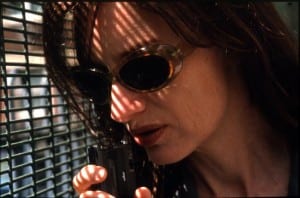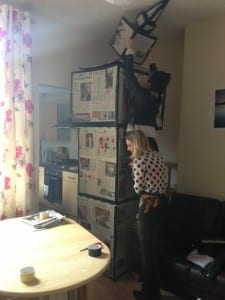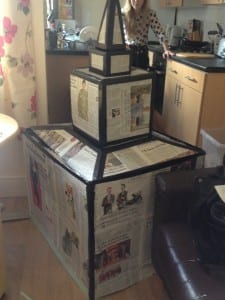We have finally performed our site specific piece, after months of development and discussion. Naturally, there are some elements that we consider less successful, and if we were to perform this piece again, it is likely we would want to be able to alter these elements. I felt our performance fell into two sections essentially, the first half in which we smuggled the Big Ben sculpture into the Usher Gallery and the second half, which seemingly began as soon as we took our balaclavas off. The difference in these two sections in terms of pace gave a much more durational feel to the piece I think, despite the 25 minute run time. This was achieved by slowing down the performance once the instillation had been built. I think this was a very successful way to stage the performance as it gave the audience time to consider our actions of ‘terrorism’ in the first part, compared to the leisurely elements of jazz music and books introduced in the second section.
However, we found a few things that could have been improved. Due to the nature of the site, we were not allowed to eat or drink in our performance area, and thus our original idea of having a quintessentially British tea party once our sculpture had been completed became obsolete. Instead, we reapplied lipstick and read leather bound books. It seems a shame that our tea party idea had to be scrapped, as the variances between the first and second sections could have been much greater and more focused on the differences in class levels traditionally found. The ladylike nature of our 1920’s costumes could also have been emphasised through this tea party, although after some discussion it was noted that our costumes had a significant impact, especially the dissimilarity between the dainty stockings and lipstick worn with black balaclavas.
It has also been discussed in depth if in fact Big Ben was an appropriate sculptural model to create; given the feminine styling we gave the performance, as it is clearly a phallic object. However, we maintain that our focus was not meant to be on the femininity versus masculinity of the Gallery or its creator, but rather on our own personal history relating to that object. Given that Big Ben is a widely recognised building, we found inspiration in the way Janet Cardiff’s 1999 ‘Missing Voice’ piece ‘seeks to alter viewing conventions more traditionally associated with tourist’ spots (Gorman 2003, p.168). Instead of our audience seeing Big Ben as London, we wanted them to look past that and see their own roots in whichever city or town they feel closest to. The feminist take is of course, another way of looking at our performance, and an interesting one at that, which we would very much like to explore should we have the opportunity to create anything similar to this piece again.
Missing Voice, Audio Tour (1999)
References: Gorman, Sarah (2003) ‘Wandering and Wondering: Following Janet Cardiff’s Missing Voice’, Performance Research 8, no.1.
Author: Lacey Cole


